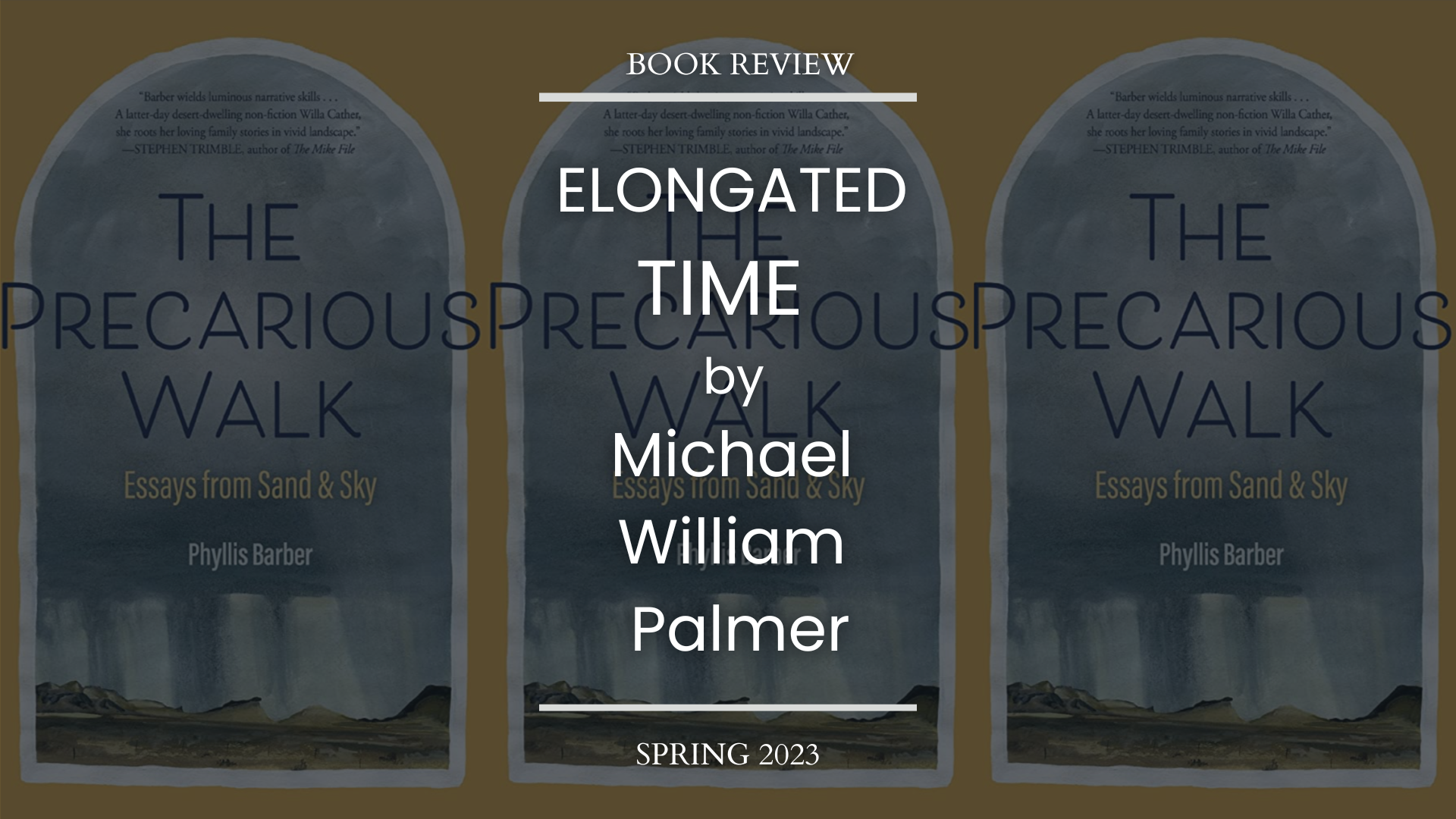Articles/Essays – Volume 56, No. 1
Elongated Time Phyllis Barber, The Precarious Walk: Essays from Sand and Sky
Phyllis Barber’s new work, The Precarious Walk: Essays from Sand and Sky, spans immense time. The book carries the reader from Barber’s childhood in post–World War II Nevada through adolescence, multiple marriages, children, relocation, ecological change, alterations in faith, unfathomable loss, and return. The ambitious scope of the book works in part because the essays are less narrative memoir than they are reflections on ideas and sensations. Over the duration of the book, the reader can piece together core events in Barber’s life—and the writing is very vulnerable at times. However, the book is more a meditation than it is a chronological story. Within an essay, Barber is as likely to introduce a narrative conflict and immediately jump fifteen years forward in order to explore an idea as she is to dive into the conflict itself, the way she might in her fiction. Her essays are focused on finding and exploring moments of “elongated quiet” (85) where time can “slow and bend and twist” (123).
The quiet reflection on place and faith harnessed in the book is distinct to Barber, who grew up in in Boulder City, Nevada, a town created by the Department of the Interior—her grandmother sang at the opening of the Hoover Dam—after descending from a line of pioneers who moved to the western United States for their faith. Barber is able to view and depict even the time preceding her life through genealogical awareness and the previous research and imagining she has done for books such as her novel And the Desert Shall Blossom. And The Precarious Walk is in many ways about time itself—how to measure it, how to draw it out, what it adds up to. What lasts despite shifting winds—core faith, scars, love, shame.
In one essay, the narrator visits the Nevada town of St. Thomas, once entirely swallowed up by water, now visible again. Her visit to the town is a solid example of the immensity that Barber grapples with routinely in these essays. She reflects on the pioneer residents of the vanished town, the remnants (or lack thereof) left by any given person after a long stretch of time, ecological transformation, ideas and fallacies of permanence, and more, all while rendering the landscape vividly. St. Thomas was flooded by a dam meant to be eternal. As she writes: “The engineers and the politicians built the dam to last forever. They created a colossal lake. But now, even though the dam will probably last into infinity, what about the water?” (49). As she observes what’s left of St. Thomas, Barber is able to feel both the initial desire to make the town flourish as part of a larger purpose and the simultaneous desire to see the Colorado River flowing without harness, the way it was before Lake Mead was created.
The book is at its strongest when Barber is able to maintain this reflective distance while simultaneously presenting the stark immediacy of narrative and sensory detail. When the reflection lacks this distance, the questions don’t resonate quite as fiercely. In the essay “Mt. Charleston on My Mind,” for example, Barber reflects on a near-death experience from her childhood when a massive boulder just missed flattening her family’s vehicle as part of a rockslide. Here, the reflective voice seems caught in-between the girl-then and the present speaker, which leads to less specificity and clarity in her questions. Similarly, the stretches back into the distant past are more effective when anchored to a known relative—her great-great-grandfather, the mail carrier in St. Thomas, for example—as opposed to imagining someone more abstract, such as a general basket-maker hundreds of years ago.
But other times, Barber manages it all remarkably, accomplishing what she aspires to when she writes: “I can lift my experiences from their limited boundaries and transform them into a unique bloom of perception” (188). It’s difficult to imagine someone without Barber’s experience—both as a person and a writer—being able to orchestrate and perceive as much as she does quite as deftly.
The book starts in the desert and ends there, and for good reason. Even if a return to her childhood is impossible, the desert is where Barber’s writing is most alive. In one essay, she describes the aftermath of a bicycle accident this way: “Blood and gravel tangled together until I couldn’t tell what was my leg and what was the desert” (214). Indeed, her story is embedded with the desert landscape just that way. And the images she shares from her desert experience linger: immense rain so loud as to be confused for F-15 jets flying overhead, watching a mushroom cloud like a movie, children gathering around to hear the story of their uncle who was “struck clean-through by lightning, his boots blown out at the soles” (71). The Precarious Walk leaves a mark and is a strong addition to Barber’s impressive body of work.
Phyllis Barber. The Precarious Walk: Essays from Sand and Sky. Salt Lake City: Torrey House Press, 2022. 240 pp. Paper: $18.95. ISBN: 978-1-948814-59-1.
Note: The Dialogue Foundation provides the web format of this article as a courtesy. There may be unintentional differences from the printed version. For citational and bibliographical purposes, please use the printed version or the PDFs provided online and on JSTOR.


 Back to full Issue
Back to full Issue

